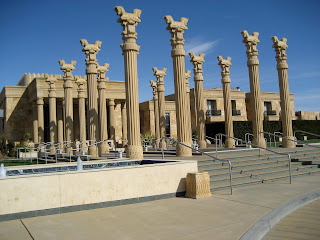Recently I visited Ridge Lytton Springs, the Sonoma county location of Ridge where they grow their signature Zinfandel blends. The main vineyard was certified organic in 2011, and it is an Italian field planting, which means that it is a mix of grape varieties including Zinfandel, Petite Sirah, Carignane, Mataro (Mourvedre), and Grenache. This is a common practice in Europe, with vineyards being planted like this and harvested together in a "field blend." At Ridge Lytton Springs, someone knows exactly which plant is what, so they know what quantity of which grape they are putting into the blended wine. Some of the vines on the Lytton Springs property are as old as 116 years - they are so old and their roots so deep that they reach the water table and don't need irrigation. In general, Ridge vineyards are dry farmed and only young, new plantings are irrigated individually until they establish a deeper root system.
A note on labeling: In the United States, in order for a wine to bear the varietal name on the label (i.e., Zinfandel) it must contain 75% of that grape. The other 25% need not be named. At Ridge, nearly all of their wines are blended, and the vineyard name is usually the distinguishing factor on the label. Ridge's Sonoma county vineyards tend to be Zinfandel-based blends, while the Santa Cruz mountains properties south of San Francisco are dominated by Bordeaux-style blends of Cabernet Sauvignon, Merlot, Petit Verdot and Cabernet Franc (including the famous Monte Bello that I have had the pleasure of tasting before).
Onto the Ridge bottlings: first,
2009 Ridge Lytton Springs. 71% Zin, 23% Petite Sirah, 6% Carignane; 14.5% alcohol by volume. It was gorgeously fruity upfront and then became spicy and earthy as it sat in the glass. Then we tried the
2003 vintage - wow. Coffee, chocolate, warm spice, herbs. Extremely balanced - 76% Zin, 18% Petite Sirah, 6% Carignane. Could age another 10 years by most people's standards, 20 years for wine geeks. We got a bottle of the 2009 and plan to age it for at least 5 years, since the 2003 was so good after 7. We could try to age it for 20 but I don't see that happening.
Next we moved to the
Geyserville vineyard, with 80 year old vines in a similar field blend but with more Carignane than Petite Sirah (17% vs 6%). The
2009 Ridge Geyserville had bright, dark red fruit and the acidity was slightly more balanced than the Lytton Springs. The
2003 vintage was more complex, with tobacco, spice, a hint of dried fruit, and a similar earthy- and herbal-ness.
A couple others we tried:
2007 Mazzoni Home Ranch - 58% Zin, 39% Carignane, 2% Petite Sirah. Similar fruit character but lighter, more spice and acidity - a great food wine, very European in style.
2010 East Bench Zinfandel - 100% Zin, from a younger vineyard. 15.1% alcohol by volume. Whoa, strawberries! Super fresh, ripe strawberries hit me immediately as I smelled and tasted it, then black pepper moved in to dry out the sweet attack. Very interesting wine.
We migrated to the barrel room at that point, where I was amazed by their stacking system and barrel processes. Every time I enter a barrel room I immediately start thinking about the logistics of the barrels - how are they stacked, how are they filled, how are they emptied? Who does this work? - since I was once in that position. At Ridge Lytton Springs, a series of ropes and pulleys hangs from the ceiling, from which the cellar workers hang to empty, clean, and fill the barrels, keeping them in their same formation, as many as 10 high. I don't quite understand how this works; I would love to see them in action. They must use pumps... but how do the barrels dry after they are washed? Wonder if I could schedule an appointment just to watch sometime. Anyway, regarding the oak barrels, Ridge uses only American oak, and only 20-25% new.

In the barrel room, there were a few special bottles open for a separate event going on, so we got to try some new wines either pending release or just released. The first was the
2009 Estate Merlot - a 100% single varietal bottling only previously made in 1974, 1976, and from 1991-1997. It had a classic Merlot aroma with spice, leather, red fruit, and vanilla. 75% new oak was used. We then had the
2009 Klein Cabernet Sauvignon, which happened to be one of the wines from the component tasting at the last
Ridge Blogger's Tasting that I attended at Monte Bello in December 2011. It's 100% Cab Sauv with classic black fruit, dark currant, juniper, eucalyptus and spice. Nine barrels were selected from the Klein vineyard to make this single varietal wine. Lastly we tried the
2009 Monte Bello, 72% Cabernet Sauvignon, 22% Merlot, and 6% Petit Verdot. It was more earthy and tannic than the previous two, with nice vanilla notes. We compared that with the
2006 Monte Bello, which was 68% Cab Sauv, 20% Merlot, 10% Petit Verdot, and 2% Cab Franc. It was very Bordeaux-like, with red fruit, leather, vanilla and warm spices. Extremely long length.
For dessert we had the
2007 Geyserville Essence, a sweet wine made from Zinfandel grapes. Lush bosenberry pie and raisins were balanced by that Ridge acidity.
I'm so glad I finally made it to Lytton Springs! Special thanks to Eliot for a wonderful tasting experience.















































